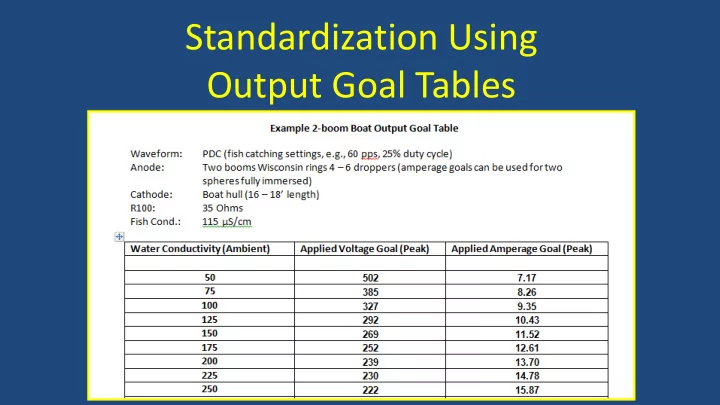

Standardization Using Output Goal Tables
Standardization Concepts • The purpose of standardization is to reduce variability in fish catchability (q); a more constant q helps CPUE data track population trends more accurately • Components to standardize include gear type, electrode design, waveform, crew number, crew experience, dipnet mesh size, sampling design (as day or night , reach length), environmental conditions (e.g., temperature and discharge), and electrical output
Output Goal Tables • The standardization aspect we are going to cover is electrical output goal tables – Peak Volts, Peak Amps, and/or Peak Power • These tables are used for guidance for selecting voltage and current based on ambient water conductivity; they can be strictly followed or used as a starting point (make trial runs near a sample site to fine tune settings)
Output Goal Tables • Output goal tables are specific to gear type, electrode design, waveform, target species or assemblages, water body type (large reservoir, shallow lake, large river, mid-sized stream). • Output goal tables are based on the power transfer model of electrofishing and require input of “threshold data” (minimum voltage, current, or power needed to successfully sample a water body type) and an estimate of fish conductivity
Inputs • We often use a fish conductivity of 115 µS/cm • Biologists should obtain threshold data and develop their own tables using the Excel file EF Goal Power or the Electrofishing App. • Protocols for gathering threshold data are at the end of this presentation.
Inputs • If you do not have your own threshold data and want to build tables, here are some suggestions. All outputs are at 115 µS/cm: Backpack with ring anode and rattail cathode: 1 amp, 240 V Barge with one ring anode: 2.5 amps, 330 V Barge with two ring anodes: 5.0 amps, 390 V Boat with 2-boom Wisconsin-type anodes: 10 amps, 300 V • Also see Table 2 in the blog “Final Electrofishing Field Blog in the Series” in electrofishing.net by Jan Dean
Important Notes • These tables may not be accurate enough for your particular equipment or sample sites. Try them and adjust as needed. We’d appreciate feedback on your experiences using these tables or your output goal tables. • Amperage is the best output to use for standardization (see recent blogs by Jan Dean). Using current as the output goal allows broader application to different electrode types. However, in low conductivity water, or when using low power units as backpacks, voltage may be a better choice to use instead of current
Let’s Make Some Tables • Use EF Goal Power
Protocol to Use Tables in Sampling 1. measure ambient water conductivity (or specific conductivity and water temperature and convert to specific [see blogs on water conductivity and meters]); 2. deploy electrodes in "fishing" fashion within typical habitat conditions; for backpacks, we suggest deploying electrodes as you would while sampling in about 1 - 1.5' depth; 3. consult the goal table; 4. standardize by volts or amps;
Protocol to Use Tables in Sampling 5. if you are using amperage, then adjust voltage until the current goal is reached as indicated on your gear's peak ammeter; 6. if you are using voltage, adjust voltage until the voltage goal is reached as indicated on your gear's peak volt meter; 7. if you have time to run a trial test, go outside but near your sample area and assess subjectively your electrofishing success; if unsatisfactory, adjust settings 8. record ambient conductivity, threshold voltage or amperage used (preferably both outputs) 9. optionally, record the major reaction of fishes (escape, inhibited swimming, attraction, immobilization) 10. optionally, record your assessment of the quality of the sampling, such as "successful" or "unsuccessful"
Protocol to Collect Threshold Data 1. Choose a waveform (AC, DC, PDC [frequency, duty cycle]) and gear type/electrode configuration 2. Take ambient water conductivity 3. Start at a low voltage setting 4. Begin electrofishing in a representative section of stream or lake 5. Note fish reactions, characterize the sampling as “successful” or “unsuccessful”; describe fish reactions as “escape”, “inhibited swimming”, or “immobilization”
Protocol to Collect Threshold Data 6. If unsuccessful, increase voltage (e.g., by 25 or 50 V) and follow steps #4 and #5 until the lowest voltage or current levels are found that result in successful electrofishing (threshold) 7. Once you have determined candidate threshold settings, increase voltage (e.g., by 25 or 50 V) and note if sampling is the same; if improved, then your initial threshold estimate was too low; if effectiveness appears the same or even declines, then use your original threshold estimate; you may change your threshold values depending upon fish recovery times (i.e., fish welfare) 8. (If successful on the first attempt, go in reverse- reduce voltage (power) and sample again; follow this procedure until successful electrofishing results) 9. If you cannot get to successful electrofishing, change waveform type or PDC attributes(frequency or duty cycle) and start over with low voltage settings
Protocol to Collect Threshold Data 10. Once you obtain successful electrofishing, record: -Ambient water conductivity (µS/cm) -Gear type (e.g., backpack, model, and electrode type and dimensions) -Voltage setting -Voltage output on meter (if available) -Current output on meter (if available) -Waveform type and attributes if PDC -Fish capture-prone response (escape, inhibited swimming, immobilization) -Water body type and size (e.g., for a stream, at least mean width, mean depth if possible)
Recommend
More recommend